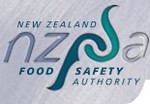Agricultural chemical use under the microscope
Results from a New Zealand Food Safety Authority (NZFSA) study looking at chemical residues in fresh, unwashed produce has found no health or food safety concerns.
This year’s Food Residue Surveillance Programme (FRSP), which targets locally-produced and imported crops prone to exceeding the maximum residue limit (MRL) for agricultural chemicals, looked at bananas, bok choi (also know as pak choi), broccoli, cucumbers, grapes, nectarines, oranges and wheat.
NZFSA principal adviser for chemicals Paul Dansted says the results were overall very pleasing. However, bok choi had a large number of non-compliant samples, with 10 out of 23 containing the fungicide chlorothalonil or the insecticide thiamethoxam over the allowable limit. The residue levels found are not a health or food safety concern.
“Although our safety assessments show that an average-sized adult weighing 70kg could eat 1.7 kilos a day of the bok choi with the highest residue for the whole of their life with no effect, this level of non-compliance is concerning and we have visited the non-compliant growers to find out why the residue levels were so high,” Dr Dansted says.
NZFSA found that when determining what agricultural chemicals to apply, growers mistakenly considered bok choi as “brassicas”, which are permitted a higher MRL for chlorothalonil of 5 mg/kg. For the purposes of residue monitoring, bok choi are actually classified as “leafy vegetables”, which have a much lower MRL of 0.1 mg/kg for chlorothalonil, even though botanically-speaking they are also brassicas.
“This understandable confusion has lead to fairly widespread non-compliance,” Dr Dansted says.
NZFSA is working with Horticulture New Zealand to inform growers of the correct use of agricultural chemicals on bok choi.
In other crops the insecticides methamidophos and thiacloprid were found at non-compliant levels in four samples of New Zealand grown cucumbers, while two samples of imported oranges contained the fungicide imazalil at non-compliant levels.
Traces of endosulfan were found in samples of cucumbers and bok choi. The chemical was banned from use in New Zealand last January. Although the levels detected are compliant with MRLs and not a food safety concern, NZFSA investigators are following up on the detections.
After conducting the annual FRSP study for eight years, Dr Dansted says the results are painting a good picture of where NZFSA should focus its effort to educate growers on the best use of agricultural chemicals.
“We are finding that the problem areas are the so-called ‘minor crops’, which are not widely grown in New Zealand. There is typically a smaller range of agricultural compounds available for growers to use on this type of produce compared with other crops, so growers must resort to unregistered or ‘off-label’ use.”
‘Off-label’ use of pesticides registered for other crops is allowed, but any residue must comply with the NZ MRL standard.
“We are able to give growers more information about off-label use so they can produce their crops in a healthy, cost-effective way.”
Results from this year’s FRSP will be released on our website:
Food Residues Surveillance Programme
For answers to common questions about agricultural compound residues in food see:
Agricultural compound residues in food
